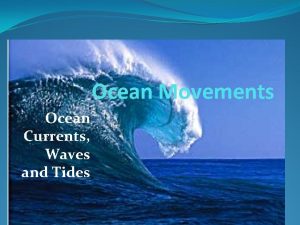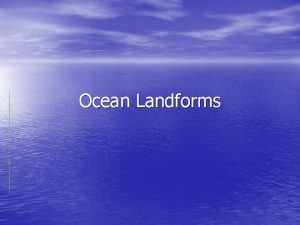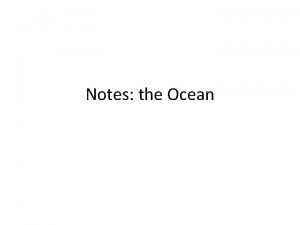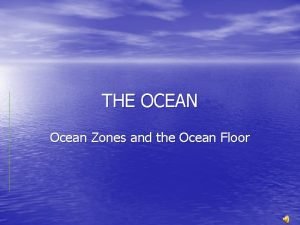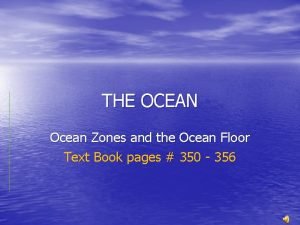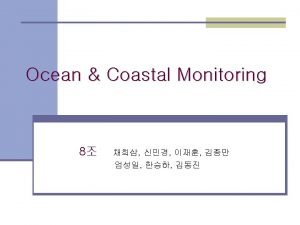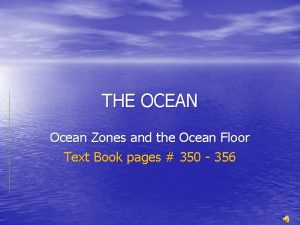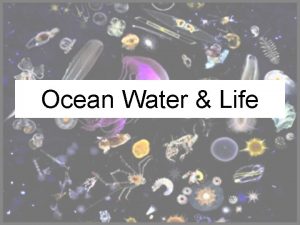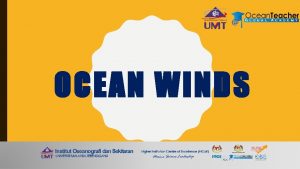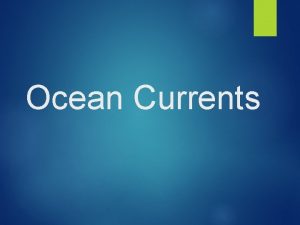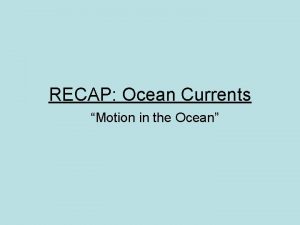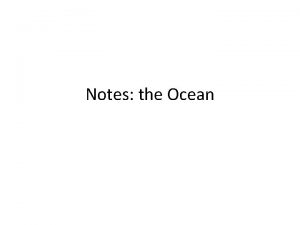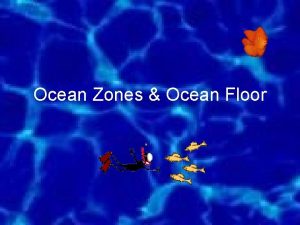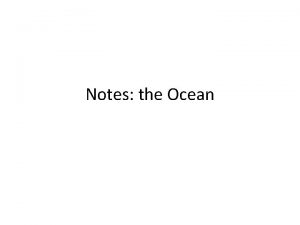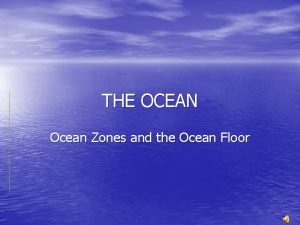National Ocean Policy A National Policy for the

















- Slides: 17

National Ocean Policy A National Policy for the Stewardship of the Oceans, Our Coasts and the Great Lakes – Established by Presidential Executive Order on July 19, 2010 Samuel D. Rauch III Deputy Assistant Administrator for NOAA’s National Marine Fisheries Service March 29, 2011

Building Blocks National Ocean Policy National Ocean Council 9 National Priority Objectives Framework for Coastal and Marine Spatial Planning (CMSP)

The US Will Promote Objectives by: • Ensuring a comprehensive and collaborative framework for the stewardship of the ocean, our coasts, and the Great Lakes that facilitates cohesive actions across the Federal Government, as well as participation of State, tribal, and local authorities, regional governance structures, nongovernmental organizations, the public, and the private sector; • Cooperating and exercising leadership at the international level, including by joining the Law of the Sea Convention; and • Supporting ocean stewardship in a fiscally responsible manner.

Policy of the U. S. to: • Protect, maintain, and restore the health and biological diversity of ocean, coastal, and Great Lakes ecosystems; • Improve the resiliency of ocean, coastal, and Great Lakes ecosystems, communities, and economies; • Bolster the conservation and sustainable uses of land in ways that will improve the health of ocean, coastal, and Great Lakes ecosystems; • Use the best available science and knowledge to inform decisions affecting the ocean, our coasts, and the Great Lakes, and enhance humanity’s capacity to understand, respond, and adapt to a changing global environment; • Support sustainable, safe, secure, and productive access to, and uses of the ocean, our coasts, and the Great Lakes; • Respect and preserve our Nation’s maritime heritage, including our social, cultural, recreational, and historical values;

Policy of the U. S. to: • Exercise rights and jurisdiction and perform duties in accordance with applicable international law, including respect for and preservation of navigational rights and freedoms, which are essential for the global economy and international peace and security; • Increase scientific understanding of ocean, coastal, and Great Lakes ecosystems as part of the global interconnected systems of air, land, ice, and water, including their relationships to humans and their activities; • Improve our understanding and awareness of changing environmental conditions, trends, and their causes, and of human activities taking place in ocean, coastal, and Great Lakes waters; and • Foster a public understanding of the value of the ocean, our coasts, and the Great Lakes to build a foundation for improved stewardship.

The National Ocean Council

National Ocean Policy Nine Priority Objectives

CMSP: Making the Case Today – Without CMS Plans Uncertain return on investment for industry Future – With CMS Plans Greater certainty and predictability Limited data availability Access to integrated data Fragmented regulatory Streamlined and time saving review process Litigation risks from opposing Reduced interests Conflicts revealed up front Unseen ‘show stoppers’ with opportunity for resolution

CMSP Implementation Regional Focus

National and Regional Workshops • A National CMSP Workshop is being planned for May 3 -5 in DC. • Federal, State, and Tribal agency leaders will be invited to attend the workshop. In addition, each Regional Fishery Management Council has the opportunity to send one representative to participate in the Workshop. • Opportunities for public participation are also being built into the workshop agenda. • Regional Workshops would be scheduled within twelve months of the National Workshop and will focus on regional specific issues related to CMSP.

Formation of Regional Planning Bodies • RPBs will likely be formed after the National workshop. • The NOC agencies have been working on developing additional guidance for RBPs composition. The NOC will also seek additional advice from the GCC on the RBP composition. • The NOC will be further assessing the relationship between RFMCs and RPBs to determine the most effective mechanism for engagement in the CMSP process. • Communication between the entities likely to form the RPBs and RFMC is important and should take place often.

Fishery Management Council Role Regional Fisheries Management Councils will play an important role in Regional CMSP Experience —bringing their expertise from decades of involvement in the science- and ecosystem-based management of fisheries. Science — providing research on fisheries biology and a wealth of economic data to support management goals. Constituents — representing commercial and recreational fishing interests. Management responsibilities — have authority to develop management and protection measures for fisheries, habitat, and deep-sea corals

Commercial and Recreational Fishing Community Commercial and recreational fishery interests will have the opportunity to engage in CMSP in two ways through: • Regional Fishery Management Council consultations with RPBs • RPB Stakeholder Engagement Processes

National Information Management System (NIMS) • The Final Recommendations call for initial actions to coordinate, integrate, and manage data in the first 6 -9 month • This includes development of a national information management system and CMSP portal, adoption of minimum data standards, and identification of additional CMSP information and research needs. • At the end of the 9 months, guidance on these fundamental pieces to the NIMS would be released as part of a strategic action plan and a prototype CMSP portal will be operational. The full scale NIMS will be built within two years. • An interagency working group has been established and has subgroups: priority science questions and relevant data layers; core functionalities, technical capabilities, and longterm management considerations; and, Minimum data standards.

President’s Budget Request NOAA $6. 77 M and $20 M Regional Grants (FY’ 11/’ 12) • Despite budget uncertainty - we still need to move forward with implementation as the Executive Order directs

NOAA’S CMSP Program Core Staff Jennifer Lukens, Director Dr. Charlie Wahle, Senior Scientist Jessica Kondel, Regional Coordinator TBD, Operations Lead NOAA Regional CMSP Leads Alaska/Arctic Region: Doug Demaster/ Amy Holman Great Lakes Region: Jennifer Day Gulf of Mexico Region: Buck Sutter Northeast Region: Betsy Nicholson Pacific Islands Region: Michael Tosatto Mid-Atlantic Region: Thomas Bigford Southeast Region: Virginia Fay Caribbean Region: Billy Causey/ Dana Wusinich-Mendez West Coast Region: John Stein/ Crescent Moegling

Questions?
 Divergent plate boundary
Divergent plate boundary Ocean ocean convergent boundary
Ocean ocean convergent boundary Ocean to ocean convergent boundary
Ocean to ocean convergent boundary Ocean ocean convergent boundary
Ocean ocean convergent boundary Chapter 15 ocean water and ocean life wordwise answer key
Chapter 15 ocean water and ocean life wordwise answer key Sciencechannel.com/activate
Sciencechannel.com/activate Convergent oceanic oceanic plate boundary
Convergent oceanic oceanic plate boundary Blue ocean strategy canvas
Blue ocean strategy canvas Kontinuitetshantering
Kontinuitetshantering Typiska novell drag
Typiska novell drag Nationell inriktning för artificiell intelligens
Nationell inriktning för artificiell intelligens Ekologiskt fotavtryck
Ekologiskt fotavtryck Varför kallas perioden 1918-1939 för mellankrigstiden
Varför kallas perioden 1918-1939 för mellankrigstiden En lathund för arbete med kontinuitetshantering
En lathund för arbete med kontinuitetshantering Kassaregister ideell förening
Kassaregister ideell förening Personlig tidbok fylla i
Personlig tidbok fylla i Sura för anatom
Sura för anatom Förklara densitet för barn
Förklara densitet för barn


















